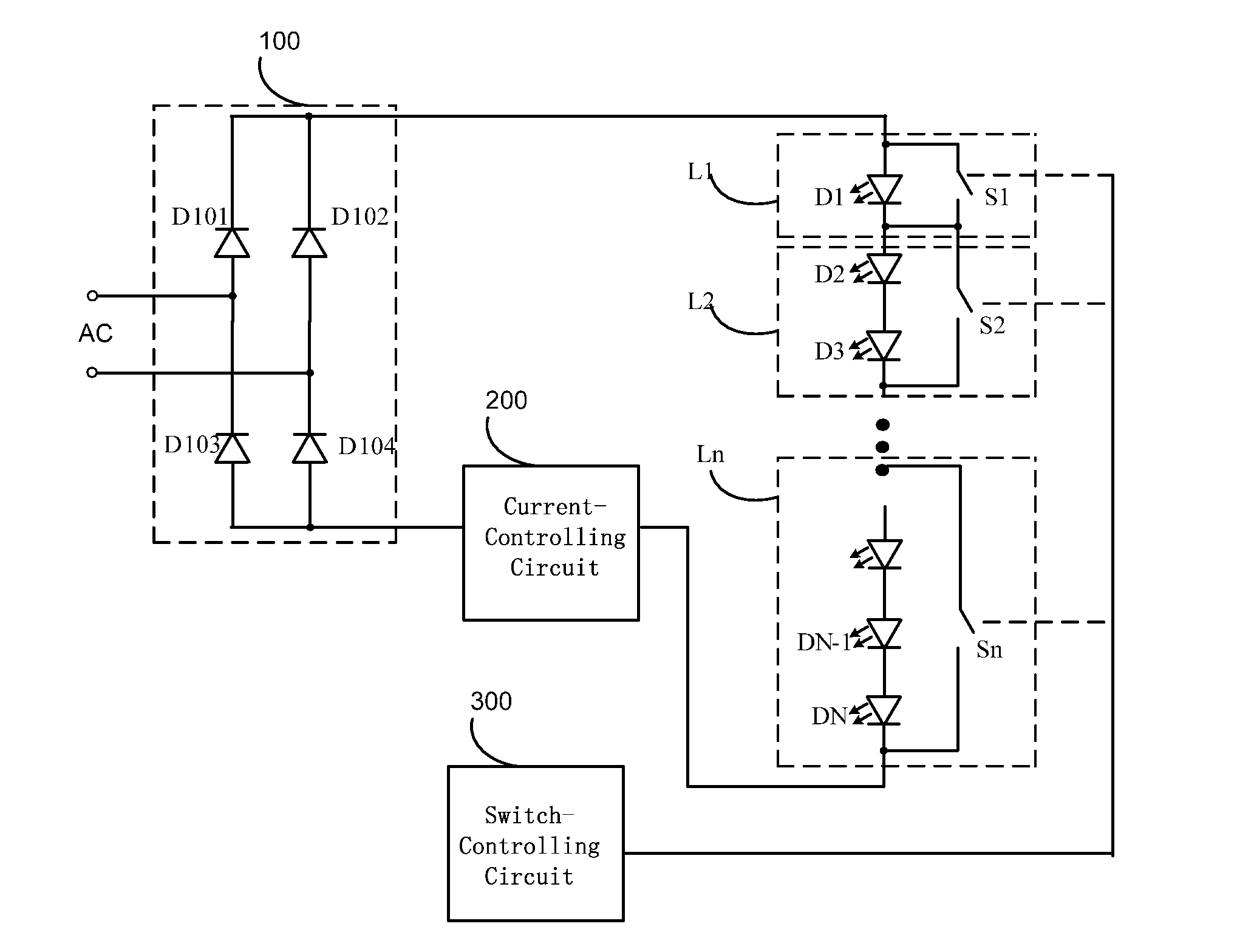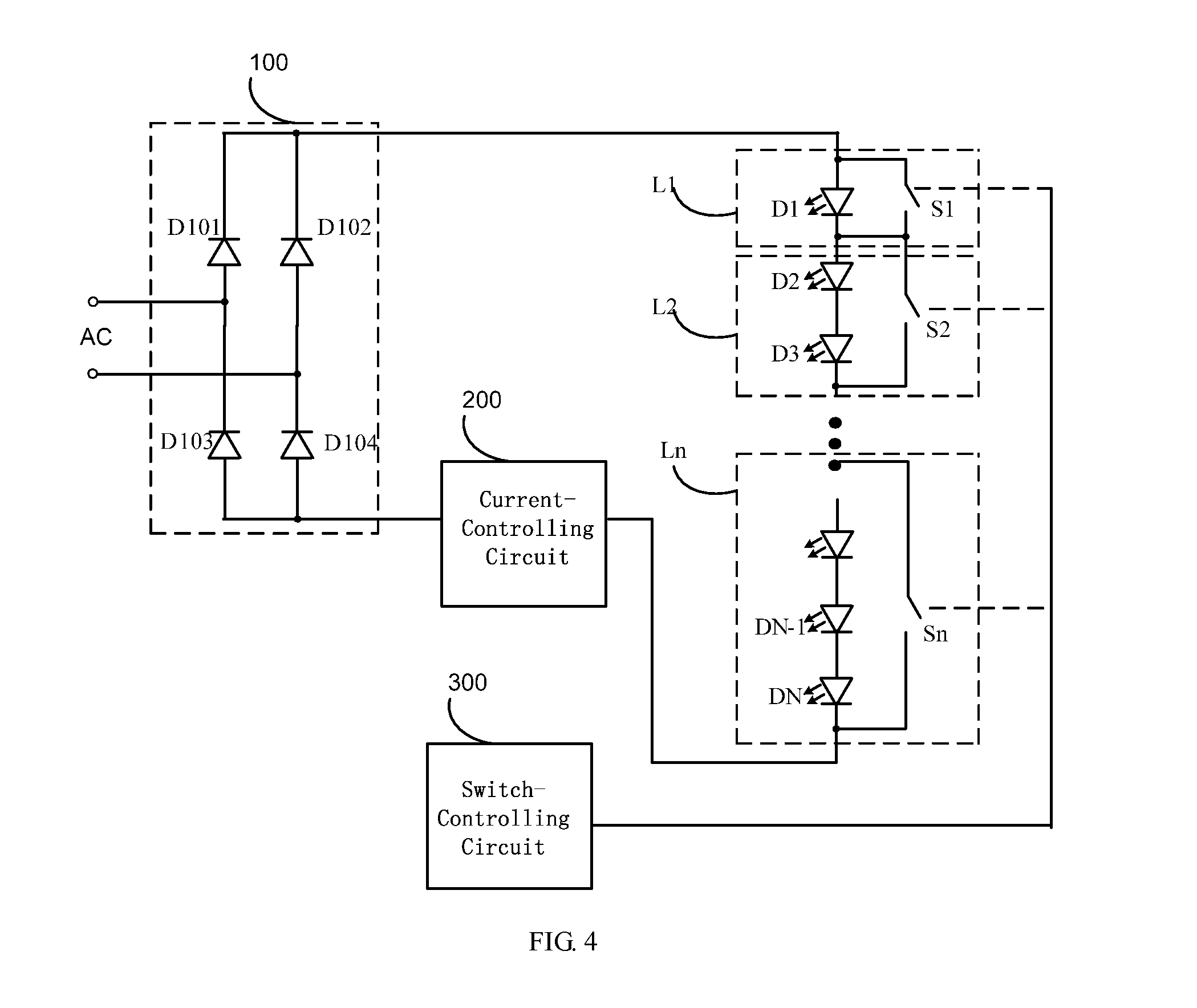Driving circuit and illumination device having light-emitting elements
- Summary
- Abstract
- Description
- Claims
- Application Information
AI Technical Summary
Benefits of technology
Problems solved by technology
Method used
Image
Examples
first exemplary embodiment
[0020]FIG. 4 is a circuit diagram of a driving circuit of a light-emitting element in accordance with a first exemplary embodiment of the present invention. The driving circuit of the light-emitting element comprises a rectifying circuit 100, a first current-controlling circuit 200, a plurality of switches (S1, S2, . . . , Sn), and a switch-controlling circuit 300.
[0021]Wherein, the rectifying circuit 100 is a full-wave rectifying circuit consisted of four diodes D101, D102, D103, D104. Input terminals of the rectifying circuit 100 are connected to output terminals of an alternating-current input power source AC, and configured for rectifying the alternating-current input power source AC (waves as shown in FIG. 2) into a direct-current voltage (waveform as shown in FIG. 3). It should be noted that, the rectifying circuit 100 also can be a half-wave rectifying circuit consisted of one or two diodes, instead of the full-wave rectifying circuit consisted of four diodes.
[0022]The first ...
second exemplary embodiment
[0030]Differences between this exemplary embodiment and the first exemplary embodiment are that, in this exemplary embodiment there are n light-emitting element subunits connected in serial, and amounts of light-emitting elements connected in parallel with switches of each of the n light-emitting element subunits are configured as a sequence consisted of the powers of 2. However, in the first exemplary embodiment, amounts of light-emitting elements connected in parallel in each of the light-emitting elements subunits are random, thus some numbers (such as 1, or 14) cannot be performed by the combinations, and it cannot completely provide the control of lightening one to the number of the whole light-emitting elements in series. In this exemplary embodiment, the amounts of the light-emitting elements connected in parallel with each switches are set to be the powers of 2, thus it can satisfy any one number from 1 to N1, and the sum of the amounts of the light-emitting elements of each...
third exemplary embodiment
[0037]Differences between this exemplary embodiment and the second exemplary embodiment are that, in this exemplary embodiment, the amounts of light-emitting elements connected in parallel with each of the switches are set to be the power of 2, but the sum N1 of the light-emitting elements of each of the light-emitting element subunits is larger than 2n-1−1 but less than 2n−1, that is, the it does not distribute the light-emitting elements of the powers of 2 to the switches respectively. In the second exemplary embodiment, N1 is equal to 2n−1, thus it can distribute the light-emitting elements of the powers of 2 to the switches respectively. This exemplary embodiment cannot distribute the light-emitting elements of the power of 2, but the combinations still can select any number from 1 to N1.
[0038]In the driving circuit, the amount of the switches is n, and an m-th switch is connected in parallel with two terminals of Am light-emitting elements connected in series, to form an m-th l...
PUM
 Login to View More
Login to View More Abstract
Description
Claims
Application Information
 Login to View More
Login to View More - R&D
- Intellectual Property
- Life Sciences
- Materials
- Tech Scout
- Unparalleled Data Quality
- Higher Quality Content
- 60% Fewer Hallucinations
Browse by: Latest US Patents, China's latest patents, Technical Efficacy Thesaurus, Application Domain, Technology Topic, Popular Technical Reports.
© 2025 PatSnap. All rights reserved.Legal|Privacy policy|Modern Slavery Act Transparency Statement|Sitemap|About US| Contact US: help@patsnap.com



